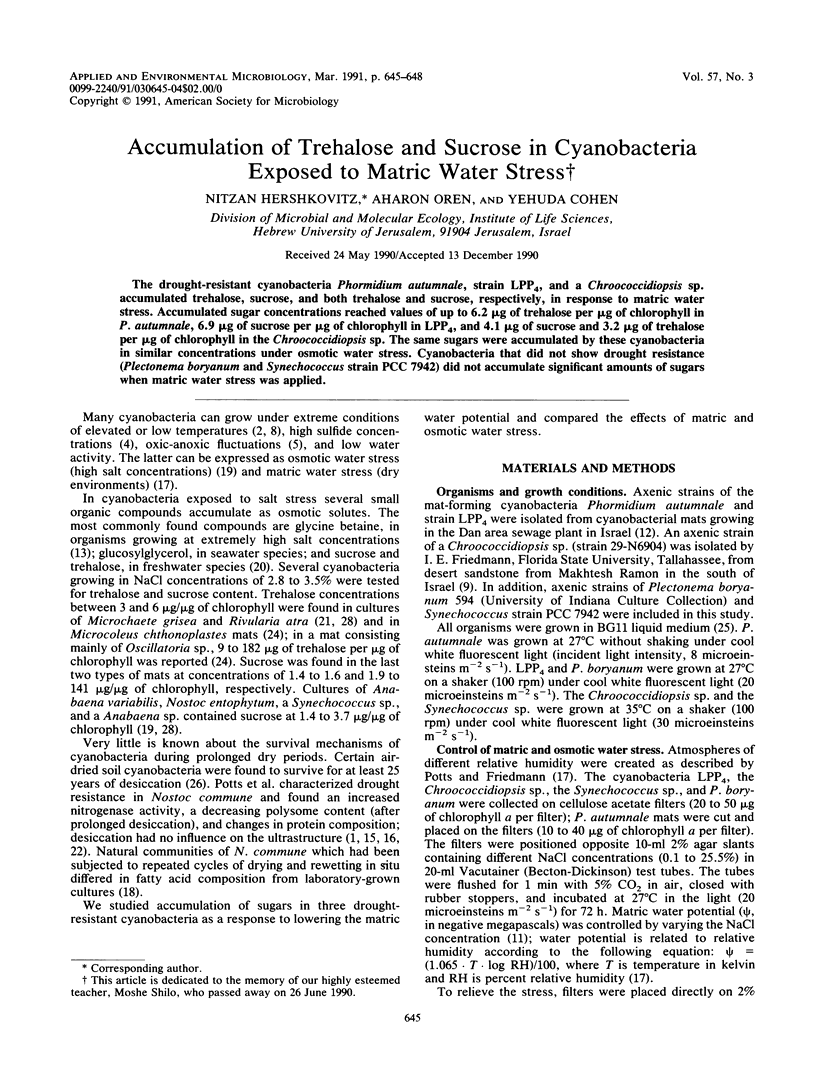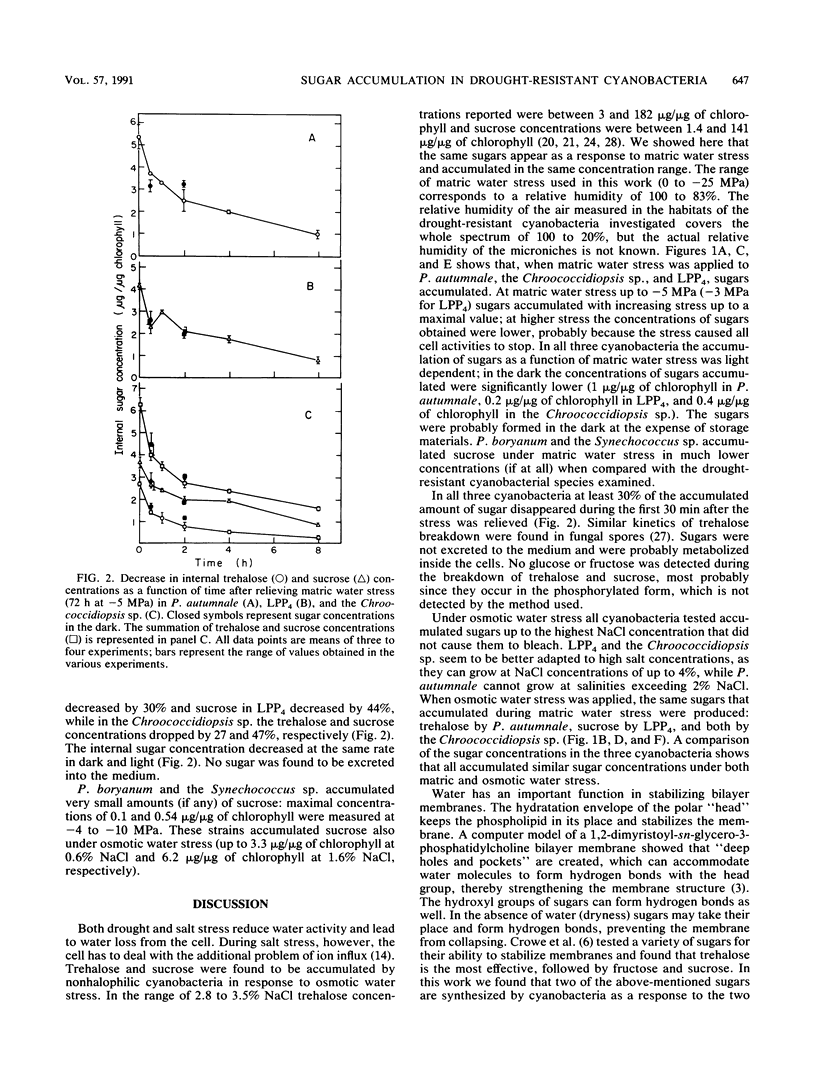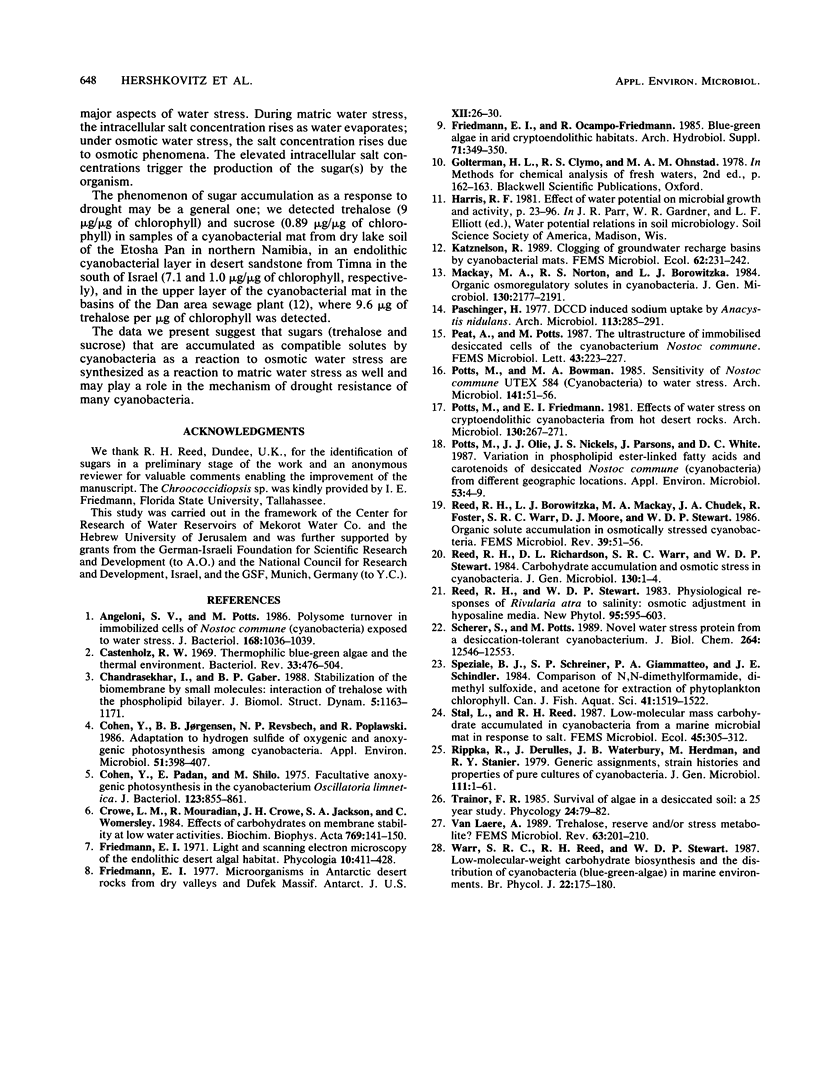Abstract
The drought-resistant cyanobacteria Phormidium autumnale, strain LPP4, and a Chroococcidiopsis sp. accumulated trehalose, sucrose, and both trehalose and sucrose, respectively, in response to matric water stress. Accumulated sugar concentrations reached values of up to 6.2 μg of trehalose per μg of chlorophyll in P. autumnale, 6.9 μg of sucrose per μg of chlorophyll in LPP4, and 4.1 μg of sucrose and 3.2 μg of trehalose per μg of chlorophyll in the Chroococcidiopsis sp. The same sugars were accumulated by these cyanobacteria in similar concentrations under osmotic water stress. Cyanobacteria that did not show drought resistance (Plectonema boryanum and Synechococcus strain PCC 7942) did not accumulate significant amounts of sugars when matric water stress was applied.
Full text
PDF



Selected References
These references are in PubMed. This may not be the complete list of references from this article.
- Angeloni S. V., Potts M. Polysome turnover in immobilized cells of Nostoc commune (cyanobacteria) exposed to water stress. J Bacteriol. 1986 Nov;168(2):1036–1039. doi: 10.1128/jb.168.2.1036-1039.1986. [DOI] [PMC free article] [PubMed] [Google Scholar]
- Castenholz R. W. Thermophilic blue-green algae and the thermal environment. Bacteriol Rev. 1969 Dec;33(4):476–504. doi: 10.1128/br.33.4.476-504.1969. [DOI] [PMC free article] [PubMed] [Google Scholar]
- Chandrasekhar I., Gaber B. P. Stabilization of the bio-membrane by small molecules: interaction of trehalose with the phospholipid bilayer. J Biomol Struct Dyn. 1988 Jun;5(6):1163–1171. doi: 10.1080/07391102.1988.10506461. [DOI] [PubMed] [Google Scholar]
- Cohen Y., Jørgensen B. B., Revsbech N. P., Poplawski R. Adaptation to Hydrogen Sulfide of Oxygenic and Anoxygenic Photosynthesis among Cyanobacteria. Appl Environ Microbiol. 1986 Feb;51(2):398–407. doi: 10.1128/aem.51.2.398-407.1986. [DOI] [PMC free article] [PubMed] [Google Scholar]
- Cohen Y., Padan E., Shilo M. Facultative anoxygenic photosynthesis in the cyanobacterium Oscillatoria limnetica. J Bacteriol. 1975 Sep;123(3):855–861. doi: 10.1128/jb.123.3.855-861.1975. [DOI] [PMC free article] [PubMed] [Google Scholar]
- Crowe L. M., Mouradian R., Crowe J. H., Jackson S. A., Womersley C. Effects of carbohydrates on membrane stability at low water activities. Biochim Biophys Acta. 1984 Jan 11;769(1):141–150. doi: 10.1016/0005-2736(84)90017-8. [DOI] [PubMed] [Google Scholar]
- Paschinger H. DCCD induced sodium uptake by Anacystis nidulans. Arch Microbiol. 1977 Jun 20;113(3):285–291. doi: 10.1007/BF00492037. [DOI] [PubMed] [Google Scholar]
- Potts M., Olie J. J., Nickels J. S., Parsons J., White D. C. Variation in Phospholipid Ester-Linked Fatty Acids and Carotenoids of Desiccated Nostoc commune (Cyanobacteria) from Different Geographic Locations. Appl Environ Microbiol. 1987 Jan;53(1):4–9. doi: 10.1128/aem.53.1.4-9.1987. [DOI] [PMC free article] [PubMed] [Google Scholar]
- Scherer S., Potts M. Novel water stress protein from a desiccation-tolerant cyanobacterium. Purification and partial characterization. J Biol Chem. 1989 Jul 25;264(21):12546–12553. [PubMed] [Google Scholar]
- Stewart A. G., Fennessy M. R. Dual modes of action for disodium cromoglycate in inhibition of antigen-induced contractions of guinea-pig isolated airways smooth muscle. Clin Exp Pharmacol Physiol. 1983 Sep-Oct;10(5):595–603. doi: 10.1111/j.1440-1681.1983.tb00228.x. [DOI] [PubMed] [Google Scholar]


